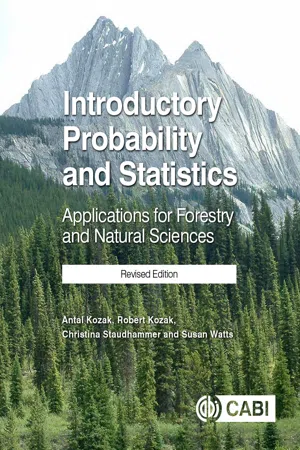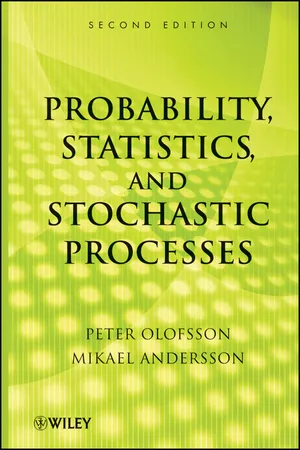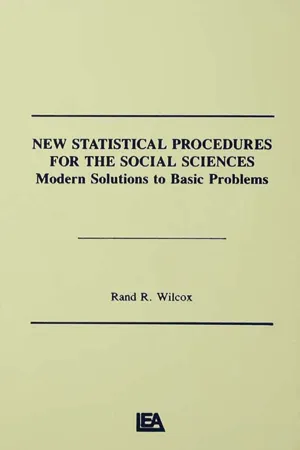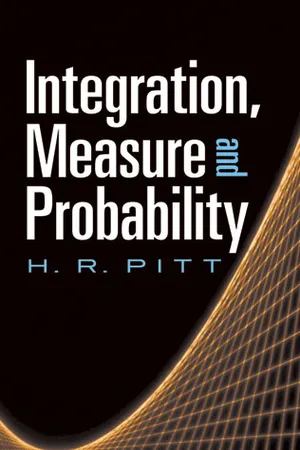Mathematics
Random Variables
Random variables are variables that take on different values as a result of random events. In probability and statistics, they are used to model and analyze uncertain outcomes. Each possible value of a random variable has an associated probability, and the behavior of random variables can be described using probability distributions.
Written by Perlego with AI-assistance
Related key terms
Related key terms
1 of 4
Related key terms
1 of 3
8 Key excerpts on "Random Variables"
- V. S. Pugachev(Author)
- 2014(Publication Date)
- Pergamon(Publisher)
CHAPTER 2 Random Variables Publisher Summary This chapter describes Random Variables. A random variable is a variable that assumes, as a result of a trial, only one of the set of possible values and with which is connected some field of events representing its occurrences in given sets, contained in the main field of events δ. Random Variables may be both scalar and vector. In correspondence with general definition of a vector, one can call a vector random variable or a random vector any ordered set of scalar Random Variables. A random variable with countable or finite set of possible values is called a discrete random variable. The distribution of a discrete random variable is completely determined by the probabilities of all of its possible values. It is impossible to determine the distribution of a random variable with an uncountable set of possible values by the probabilities of its values. Therefore, another approach to such Random Variables is necessary. 2.1 General definitions. Discrete Random Variables 2.1.1 Definition of a random variable In Section 1.2.1 an intuitive definition of a random variable was given based on experimentally observable facts, and it was shown that with every random variable may be connected some events, its occurrences in different sets. For studying Random Variables it is necessary that the probabilities be determined for some set of such events, i.e. that this set of events belongs to the field of events δ connected with a trial. Furthermore, it is expedient to require that this set of events be itself a field of events (a subfield of the field δ)- eBook - ePub
Introductory Probability and Statistics
Applications for Forestry and Natural Sciences (Revised Edition)
- Robert Kozak, Antal Kozak, Christina Staudhammer, Susan Watts(Authors)
- 2019(Publication Date)
- CAB International(Publisher)
4 Random Variables and Probability DistributionsOutcomes of Random ExperimentsLike the theory of probability, Random Variables and their probability distributions play an important role in statistical inference . The main objectives of this chapter are to show how outcomes of random experiments can be described in real (numerical) terms and how probabilities can be assigned to these real numbers. Numerical descriptions of outcomes and their respective probabilities form what are known as probability distributions or probability density functions. We can use these distributions to compute the means and the variances of the Random Variables that they describe. All of these tools are useful in helping to provide further information for describing populations.4.1 Random Variables
In Chapter 3 (this volume), we discussed the concepts of random experiments, sample spaces and outcomes. Some random experiments produce outcomes that can be described by letters, symbols or just general descriptions. Other experiments produce outcomes in numerical terms, such as: the number of heads that could occur when a coin is tossed three times; the total number of dots observed when rolling a pair of dice; the number of plants in a 100 m2 area; or the number of seeds that germinate in a seedbed. A random variable is a well-defined numerical description of the outcomes in the sample space of a random experiment. We will denote Random Variables by capital letters, such as X, Y or Z , while small letters, such as x, y or z (usually with subscripts), will denote individual values or outcomes for that random variable.A sample space associated with a random ex periment can be classified as discrete or con tinuous. A discrete sample space - eBook - ePub
- Guo-Qiang Cai, Wei-Qiu Zhu(Authors)
- 2016(Publication Date)
- WSPC(Publisher)
ω ∈ Ω. We have theA random variable X (ω ), ω ∈ Ω, is a function defined on a sample space Ω, such that for every real number x there exists a probability that X (ω ) ≤ x , denoted by Prob[ω : X (ω ) ≤ x ].For simplicity, the argument ω in X (ω ) of a random variable is usually omitted, and the probability can be written as Prob[X ≤ x ].There are two types of Random Variables: discrete and continuous. A discrete random variable takes only a countable number, finite or infinite, of distinct values. On the other hand, the sample space of a continuous random variable is an uncountable continuous space. following definition:A random variable can be either a single-valued quantity or an n -dimensional vector described by n values. Except specified otherwise, we assume implicitly that a random variable is a singlevalued quantity in the book.2.2Probability Distribution
Since a random variable is uncertain, we can describe it in terms of probability measure. For a discrete random variable, the simplest and direct way is to specify its probability to take a possible discrete value, written asIn the notationPX(x ), X is the random variable, and x is the state variable, i.e., the possible value of X . The convention of using a capital letter to denote a random quantity and a low case letter to represent its corresponding state variable will be followed throughout the book.Another probability measure to describe a random variable is known as the probability distribution function, denoted asFX(x - Peter Olofsson, Mikael Andersson(Authors)
- 2012(Publication Date)
- Wiley(Publisher)
Chapter 2 Random Variables2.1 Introduction
We saw in the previous chapter that many random experiments have numerical outcomes. Even if the outcome itself is not numerical, such as the case is Example 1.4, where a coin is flipped twice, we often consider events that can be described in terms of numbers, for example, {the number of heads equals 2}. It would be convenient to have some mathematical notation to avoid the need to spell out all events in words. For example, instead of writing {the number of heads equals 1} and {the number of heads equals 2}, we could start by denoting the number of heads by X and consider the events {X = 1} and {X = 2}. The quantity X is then something whose value is not known before the experiment but becomes known after.Definition 2.1. A random variable is a real-valued variable that gets its value from a random experiment.There is a more formal definition that defines a random variable as a real-valued function on the sample space. If X denotes the number of heads in two coin flips, we would thus, for example, have X (HH ) = 2. In a more advanced treatment of probability theory, this formal definition is necessary, but for our purposes, Definition 2.1 is enough.A random variable X is thus something that does not have a value until after the experiment. Before the experiment, we can only describe the set of possible values, that is, the range of X and the associated probabilities. Let us look at a simple example.Example 2.1. Flip a coin twice and let X denote the number of heads. Then X has range {0, 1, 2} and the associated probabilities areand we refer to these probabilities as the distribution of X .In the last example, any three numbers between 0 and 1 that sum to 1 is a possible distribution (recall Section 1.4), and the particular choice in the example indicates that the coin is fair. Let us next restate some of the examples from Section 1.2 in terms of Random Variables. In each case, we define X- eBook - ePub
Biometry for Forestry and Environmental Data
With Examples in R
- Lauri Mehtätalo, Juha Lappi(Authors)
- 2020(Publication Date)
- Chapman and Hall/CRC(Publisher)
2 Random Variables2.1 Introduction to Random VariablesRandom Variables are variables that can exhibit different values depending on the outcome of a random process. The value assigned to a random variable due to a specific outcome of an experiment is called realization. The random variable itself cannot be observed, but the realized value can be. However, realization of a random variable does not include all the information of the properties of the random variable. Furthermore, several realizations include more information than just a single one. A variable that is not random is fixed.Terms such as measurement and observation are often used synonymously with realization. However, ‘observation’ can also mean the unit or the subject from which we make measurements, and we can measure several variables for each unit. Measurements of a given property of a unit are called variables. For example, trees of a certain area may be the units selected for measurements of diameter, height, species, volume and biomass. Some quantities cannot be measured for practical or theoretical reasons, and they are called latent variables.Whenever the distinction between the random variable and the realized/observed value is explicitly shown, a common practice is to denote the random variable by an uppercase letter and the realized value by a lowercase letter. For example, X = x and Y = 2 means that values x and 2 were assigned to Random Variables X and Y, respectively, by some random processes.2.1.1 Sources of randomnessAn intuitive reason for the randomness may be sampling: the unit was selected from a population of units randomly, and therefore any characteristic that one observes from that particular unit is affected by the unit selected. Another way of thinking is to assume that there is a certain, usually unknown random process, which generated the value for the unit of interest. - eBook - ePub
New Statistical Procedures for the Social Sciences
Modern Solutions To Basic Problems
- Rand R. Wilcox(Author)
- 2013(Publication Date)
- Psychology Press(Publisher)
CHAPTER THREE Random Variables, DISTRIBUTIONS AND ESTIMATION3.1 Random Variables
In probability theory the sample space can consist of any collection of objects or events that are of interest. However, when trying to develop statistical techniques, it is convenient to restrict attention to sample spaces containing only numbers. Fortunately, for the problems considered in this book, assigning numbers to outcomes is a simple process. In many cases the numbers used to describe outcomes suggest themselves in an obvious way. For example, when measuring how much people weigh, a pointer on the scale might indicate the symbol “120,” and so you would use 120 as the person's weight. In other cases numbers can be assigned in an arbitrary but convenient fashion that is appropriate for the problem at hand. For instance, if you want to conduct a study that deals with whether students pass (P) or fail (F) a statistics course, it turns out to be convenient to designate a “pass” with the number 1, and a “fail” with the number 0. The reader might not be completely convinced that assigning numbers to outcomes is always a simple matter, but eventually this will become clear.Definition 3.1.1. A random variable, X, is a rule (or function) that assigns a unique number to any element of the sample space . The set of possible values of the random variable X is called the space of X.Example 3.1.1. Consider again the situation where students either pass or fail a course. Then the random variable X is defined byandHowever, it is cumbersome to write X(P) and X(F), and so it is more common to simply say that X equals 1 or 0 according to whether a student passes or fails. The only reason for writing X(P)=1 was to emphasize that X is a function that assigns the number 1 to the event P.From chapter two - eBook - ePub
- Bernard Lindgren(Author)
- 2017(Publication Date)
- Routledge(Publisher)
3Random VariablesIn selecting a population member at random, or performing any experiment of chance for which a probability structure has been postulated, it is common for one to focus on and observe some quantity or quality associated with the outcome. Since what is observed depends on the outcome of an experiment of chance, we call it a random variable . Thus, the random variable X is simply a function X defined on a probability space Ω.What one observes about an outcome ω may be a number , or possibly a vector of numbers. Some reserve the terms “random variable” and “random vector” for these cases, respectively. However, qualitative aspects of ω are also variable, and there is no reason not to think of them as Random Variables. Thus, when ω denotes an individual drawn at random from some population, the age of that individual is a numerical random variable, and eye color is a qualitative or categorical random variable.3.1 Discrete Random Variables
Consider first the case of discrete Ω, in which all subsets are “events” and have assigned probabilities. The value-space of a function X can only be discrete, and we can define probabilities in this space by assigning probabilities to the individual possible “values.” (These can be either numbers or category labels.) Thus, the probability of [X = a ] is the probability of the set of ω ’s such that X (ω ) = a :P( X = a )= P(={ ω : X)( ω )= a }∑PX( ω )= a( ω ).With probabilities of individual values so defined, the value space of X is a discrete probability space.When Ω is not discrete, the value space of a function X may or may not be discrete. When the value-space of X is discrete (whether Ω itself is discrete or not), we say that X is a discrete random variable . The possible values are countable: (x 1 , x 2 , ...}. This value-space is a discrete probability space when we define the probability of a set of values as the sum of the probabilities of its elements. The distribution of probability in this space, also referred to as the distribution of X , is defined by the probability function (p.f.) - eBook - ePub
- H. R. Pitt(Author)
- 2013(Publication Date)
- Dover Publications(Publisher)
Chapter 4Random Variables AND PROBABILITY
§13. DEFINITIONS AND BASIC IDEASThe application of the foregoing theory of measure to the study of probability is based on the principle, first enunciated in its present form by Kolmogoroff † , that all statements involving the notion of probability can be expressed as statements about the measures of sets in an appropriate space. Our first task is to show how this can be done.The basic terms are random variable and probability , and we must either define them or give a precise meaning to every sentence in which they occur. All that is necessary if we adopt the second alternative is that we understand the two sentences(i) x is a random variable in the space ,(ii) the probability that x belongs to X is p or, in symbols, P {x X } =pto mean that a probability measure (or probability distribution) is defined in , that X is measurable and that (X ) = p . There is no need to deal with the sentences (i) and (ii) separately since it is invariably found that (i) is followed by one or more statements, which may be hypotheses or conclusions, of type (ii). In fact, from this point of view it is not necessary to go any further and say what a random variable is —any more than it is necessary to define the isolated symbol in analysis.This has been done, however, by Kolmogoroff in the case of Random Variables in the space of real numbers. He says that a random real variable is a real valued function over a space which is measurable with respect to a probability measure in After Theorem 31 of Section 7 , the measure in induces a probability measure in and this could equally well be used as the basic measure of the random variable, which would then become (in Kolmogoroff’s usage) the identity function over . Conversely, a probability measure in
Index pages curate the most relevant extracts from our library of academic textbooks. They’ve been created using an in-house natural language model (NLM), each adding context and meaning to key research topics.
Explore more topic indexes
Explore more topic indexes
1 of 6
Explore more topic indexes
1 of 4







